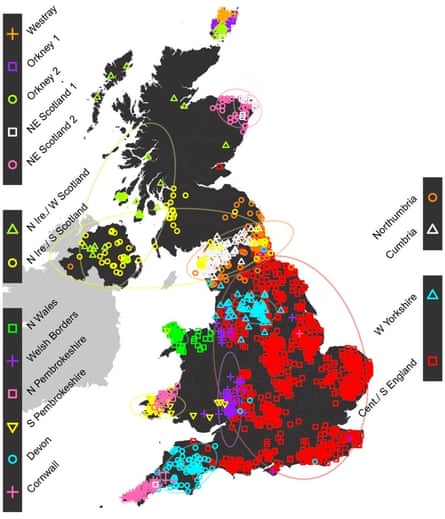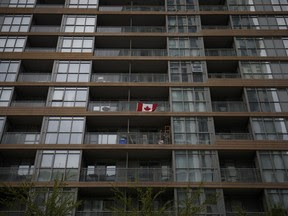Genetic study reveals 30% of white British DNA has German ancestry
Analysis over 20 years reveals heavy Anglo-Saxon influence, with French and Danish DNA coming from earlier migrations than the Normans or Vikings
Hannah Devlin science correspondent@hannahdevWed 18 Mar 2015 18.00 GMTLast modified on Wed 14 Feb 2018 21.43 GMT
The Romans, Vikings and Normans may have ruled or invaded the British for hundreds of years, but they left barely a trace on our DNA, the first detailed study of the genetics of British people has revealed.
The analysis shows that the Anglo-Saxons were the only conquering force, around 400-500 AD, to substantially alter the country’s genetic makeup, with most white British people now owing almost 30% of their DNA to the ancestors of modern-day Germans.
People living in southern and central England today typically share about 40% of their DNA with the French, 11% with the Danes and 9% with the Belgians, the study of more than 2,000 people found. The French contribution was not linked to the Norman invasion of 1066, however, but a previously unknown wave of migration to Britain some time after then end of the last Ice Age nearly 10,000 years ago.
Prof Peter Donnelly, director of the Wellcome Trust Centre for Human Genetics at the University of Oxford, who co-led the research, said: “It has long been known that human populations differ genetically, but never before have we been able to observe such exquisite and fascinating detail.”
The study found that people’s ancestral contributions varied considerably across Britain, with people from areas of Wales, Scotland and Northern Ireland emerging as separate genetic clusters, providing a scientific basis to the idea of regional identity for the first time.

Map of the UK showing clustering of individuals based on genetics, and its striking relationship with geography. Photograph: Stephen Leslie/Nature/EuroGeographics
The population of the Orkney Isles was found to be the most genetically distinct, with 25% of DNA coming from Norwegian ancestors who invaded the islands in the 9th century.
The Welsh also showed striking differences to the rest of Britain, and scientists concluded that their DNA most closely resembles that of the earliest hunter-gatherers to have arrived when Britain became habitable again after the Ice Age.
Surprisingly, the study showed no genetic basis for a single “Celtic” group, with people living in Scotland, Northern Ireland, Wales and Cornwall being among the most different form each other genetically.
“The Celtic regions one might have expected to be genetically similar, but they’re among the most different in our study,” said Mark Robinson, an archaeologist from the Oxford University Museum of Natural History and a co-author. “It’s stressing their genetic difference, it’s not saying there aren’t cultural similarities.”
The study, published on Wednesday in the journal Nature, is the culmination of 20 years of work. Scientists began collecting DNA samples from people in Orkney in 1994 and gradually worked across most of the British Isles.
The participants were all white British, lived in rural areas and had four grandparents all born within 50 miles (80km) of each other. Since a quarter of our genome comes from each of our grandparents, the scientists were effectively obtaining a snapshot of British genetics at at the beginning of the 20th century.
Sir Walter Bodmer, of the University of Oxford, who conceived the study, said: “We’re reaching back in time to before most of the mixing of the population, which would fog history.”
The team also looked at data from 6,209 individuals from 10 European countries to reconstruct the contributions their ancestors made to the genetic makeup of the British.
The analysis shows that despite the momentous historical impact on British civilisation of the Roman, Viking and Norman invasions, none of these events did much to alter the basic biological makeup of people living here. The findings support records suggesting that few high ranking Roman officials settled in Britain and that they and their families remained largely segregated from the local Celts.
The Danish Vikings, who ruled over large swathes of Britain from 865AD, are known to have inter-married with locals, but the latest study shows that the conquering force, while powerful, must have comprised relatively few fighters.
“There were very large numbers of people – hundreds of thousands – in those parts of Britain, so to have a substantial impact on genetics there would have to be very large numbers of them,” said Robinson. “The fact that we don’t see that reflects the numbers rather than the relative allure or lack thereof of Scandinavian men to British women.”
The analysis also settles a long-running dispute about the nature of the Anglo-Saxon takeover of England following the collapse of the Roman empire. The replacement of the Celtic language by Anglo-Saxon and the complete shift towards North-West German farming and pottery styles has led some to suggest that local populations must have retreated to Wales or even been wiped out in a genocide.
“[Our results] suggest that at least 20% of the genetic makeup in this area is from Anglo-Saxon migrants, and that there was mixing,” said Robinson. “It is not genocide or complete disappearance of Britons.”
The authors suggest that DNA analysis should now be regarded as a powerful historical tool, sometimes providing more impartial information than traditional sources.
“Historical records, archeology, linguistics – all of those records tell us about the elites. It’s said that history is written by the winners,” said Donnelly. “Genetics complements that and is very different. It tells us what is happening to the masses… the ordinary folk.”
Timeline
9600 BC Last Ice Age ends and land is colonised by hunter-gatherers
2500 BC Influx of settlers from east and western coastal routes
54 BC Julius Caesar invades Britain and defeats the British tribal chief Cassivellaunus
410 AD Collapse of Roman rule in Britain, which descends into the chaos of a failed state
400-500 AD Large influx of Angles and Saxons
600-700 AD Anglo-Saxon rule throughout much of Britain – Welsh kingdoms successfully resist
865 AD Large-scale invasion by Danish Vikings
1066 AD Norman invasion



 Newly minted housing minister Sean Fraser, who recently said he will be increasing housing affordability without bringing down real estate prices. The sentences are mutually exclusive. Photo by Justin Tang/The Canadian Press
Newly minted housing minister Sean Fraser, who recently said he will be increasing housing affordability without bringing down real estate prices. The sentences are mutually exclusive. Photo by Justin Tang/The Canadian Press A Canadian flag on a condo balcony in Toronto. The city suffers from health-care shortages and unaffordable housing prices. Photo by Cole Burston/Bloomberg
A Canadian flag on a condo balcony in Toronto. The city suffers from health-care shortages and unaffordable housing prices. Photo by Cole Burston/Bloomberg
